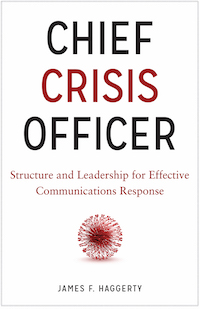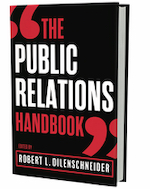Every company, large or small, needs to have a communications plan in place to deal with a crisis, writes James Haggerty in his engaging new book, Chief Crisis Officer. Proper crisis communications techniques “are essential to all organizations that want to minimize reputational risk,” according to the principal of PRCG | Haggerty and founder of cloud-based crisis communications software firm, CrisisResponsePro.
 |
Chief Crisis Officer takes readers through the steps of formulating an effective crisis program and choosing the appropriate leaders to put that plan into place. Using a wealth of examples, from the Target data breach to the Tylenol scandal of the 1980s, he illustrates how those companies can take control of the narratives surrounding even the most damaging events.
Doing that, he says, entails careful preparation plus the ability to act quickly once a crisis hits. A good crisis plan takes the form of what Haggerty calls “a roadmap for action,” a clearly laid out set of procedures that can be implemented at a moment’s notice, allowing the crisis communications staff to get a handle on a situation before the threat of things spinning out of control turns into reality.
But even the best plan isn’t going to head off a problem, the book tells us, without the right person in the driver’s seat. The Chief Crisis Officer needs to be a strong leader, decisive yet open to change, and perhaps most importantly, cool under pressure. Haggerty uses a sports metaphor to describe the right person for the job, and it’s a good one. “The perfect Chief Crisis Officer,” he writes, “is like a good point guard in basketball: They know the playbook by heart, they execute on the fundamentals, and they have ‘court vision,’ which allows them to be flexible and take advantage of opportunities as they develop.”
Another thing the Chief Crisis Officer needs is authority. Without the power to make immediate decisions, Haggerty says, the essential factors of effective crisis management—speed and control—are lost. He recommends keeping things as streamlined as possible, which cuts down on the danger of getting tangled up in red tape at a critical moment.
Haggerty’s conversational writing style and clear sense of organization make this book an effective primer for those looking to add crisis management skills to their organizational repertoire. And an afterword that consists of interviews with several crisis management veterans gives an extra dose of real-world knowledge to the book.
Chief Crisis Officer is available at Amazon.com and from the American Bar Association website.


 Time correspondent Simon Shuster’s “The Showman” demonstrates how Ukraine president Volodymyr Zelensky’s masterful knowledge of PR tactics and the power of propaganda transformed him from comedian into a respected world leader.
Time correspondent Simon Shuster’s “The Showman” demonstrates how Ukraine president Volodymyr Zelensky’s masterful knowledge of PR tactics and the power of propaganda transformed him from comedian into a respected world leader. Iuliia Mendel, who served as press secretary for Ukraine president Volodymyr Zelensky from 2019 to 2021, will release a book called “The Fight Of Our Lives” in September, published by Simon & Schuster’s One Signal Publishers.
Iuliia Mendel, who served as press secretary for Ukraine president Volodymyr Zelensky from 2019 to 2021, will release a book called “The Fight Of Our Lives” in September, published by Simon & Schuster’s One Signal Publishers. Robert Dilenschneider, former CEO of Hill and Knowlton, is releasing the fifth edition of The Public Relations Handbook on Feb. 15.
Robert Dilenschneider, former CEO of Hill and Knowlton, is releasing the fifth edition of The Public Relations Handbook on Feb. 15.  Big Advertising may be down for the count, but the power of marketing lives on. That’s the big takeaway from Paul Dyer’s “Friction Fatigue,” a look at what advertising’s downward spiral means for “future-focused brands."
Big Advertising may be down for the count, but the power of marketing lives on. That’s the big takeaway from Paul Dyer’s “Friction Fatigue,” a look at what advertising’s downward spiral means for “future-focused brands." Sabrina Horn, the high-tech PR guru who sold her Horn Group to Finn Partners in 2015, has published “Make It, Don’t Fake It.”
Sabrina Horn, the high-tech PR guru who sold her Horn Group to Finn Partners in 2015, has published “Make It, Don’t Fake It.”


 Have a comment? Send it to
Have a comment? Send it to 
No comments have been submitted for this story yet.